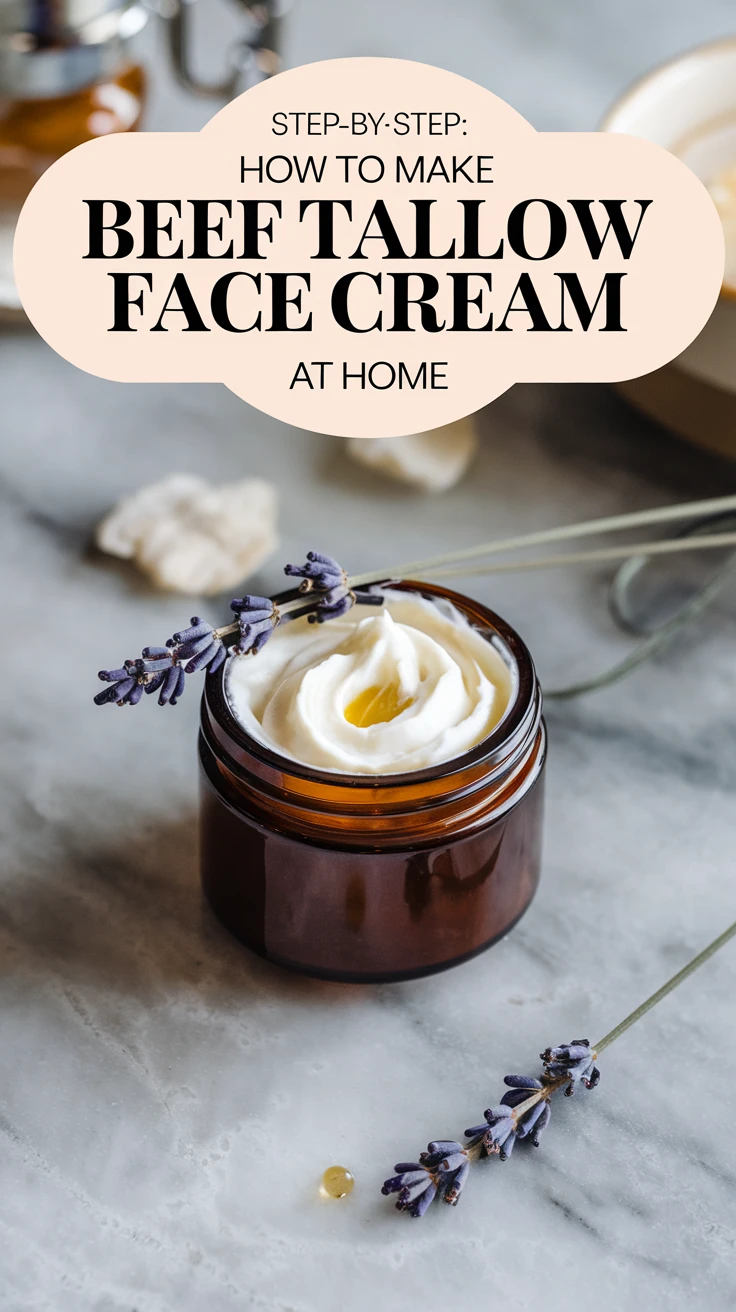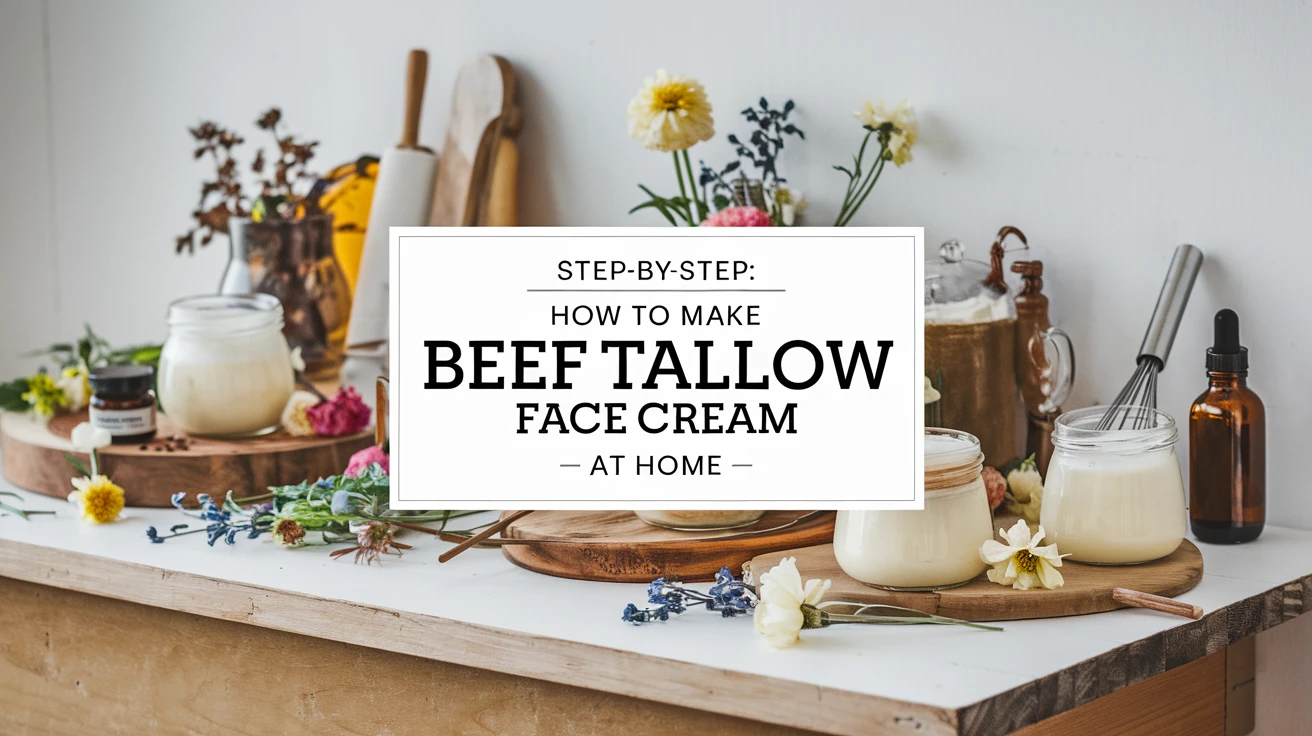
Introduction
There’s something wonderfully old-school about making your own skincare products, isn’t there? And when it comes to how to make beef tallow face cream, you’re not just joining a trendy DIY movement—you’re tapping into centuries of traditional wisdom. I stumbled upon tallow-based skincare a few years ago when my sensitive skin rebelled against every store-bought product I tried. Let me tell you, it was a game-changer!
Beef tallow (rendered beef fat) might sound like an unusual skincare ingredient in our era of glossy packaging and unpronounceable ingredients, but it was actually a staple in beauty routines long before commercial moisturizers existed. Why? Because its molecular structure is remarkably similar to our skin’s own oils, making it incredibly compatible with human skin. Ready to create this powerhouse moisturizer in your own kitchen? Let’s dive in!
![]() As an Amazon Associate, I earn from qualifying purchases.
As an Amazon Associate, I earn from qualifying purchases.
1. Understanding Why Beef Tallow Makes Excellent Skincare
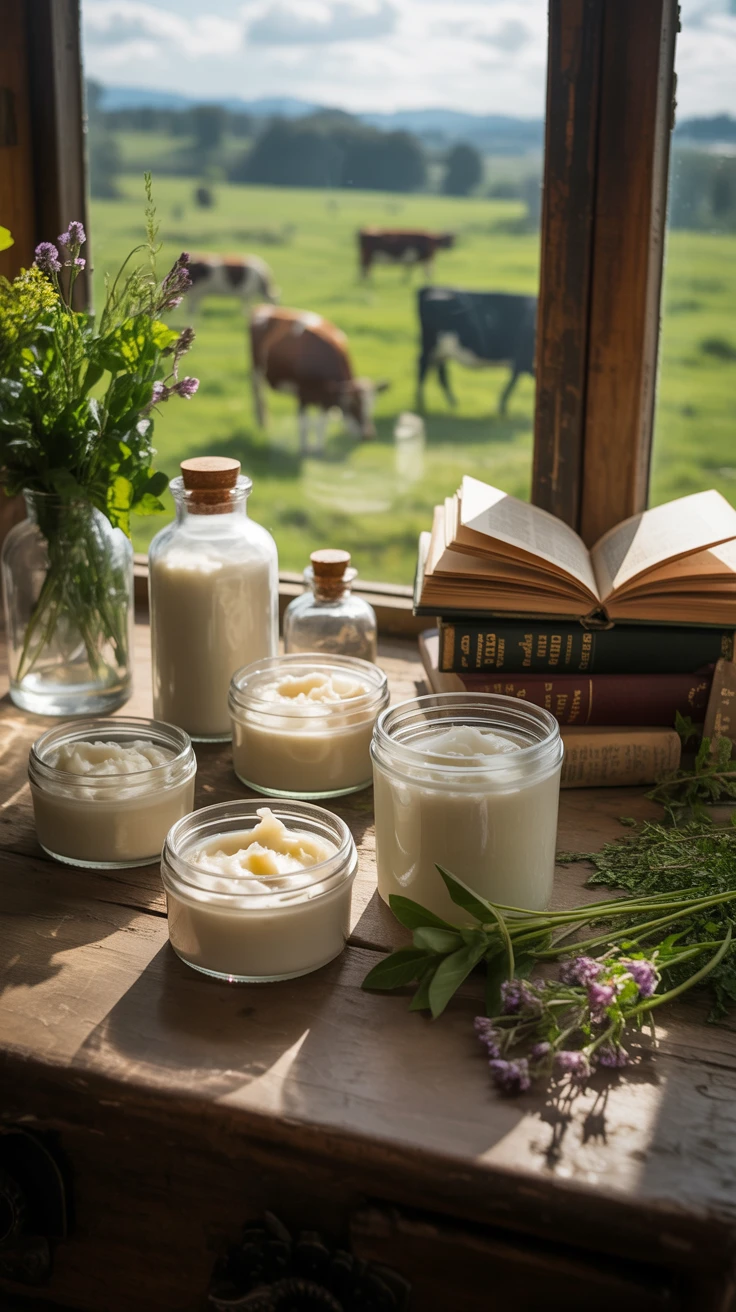
Before we get our hands greasy (in the best way possible), let’s talk about why beef tallow deserves a spot in your skincare routine. I was skeptical at first too—putting animal fat on my face seemed counterintuitive until I researched the science behind it.
- Tallow contains vitamins A, D, E, and K—all crucial for skin health and regeneration
- It’s rich in conjugated linoleic acid (CLA), which has anti-inflammatory properties
- The fatty acid profile closely resembles human sebum, making it deeply nourishing
- It creates a protective barrier without clogging pores (when properly prepared)
- Tallow from grass-fed cows contains higher nutrients than conventional sources

View on AmazonAs an Amazon Associate, I earn from qualifying purchases.

View on AmazonAs an Amazon Associate, I earn from qualifying purchases.
Pro Tip: While commercial moisturizers often contain petroleum derivatives that sit on top of skin, tallow actually penetrates and nourishes from within—making it perfect for mature or extremely dry skin types.
2. Gathering Your Ingredients and Equipment
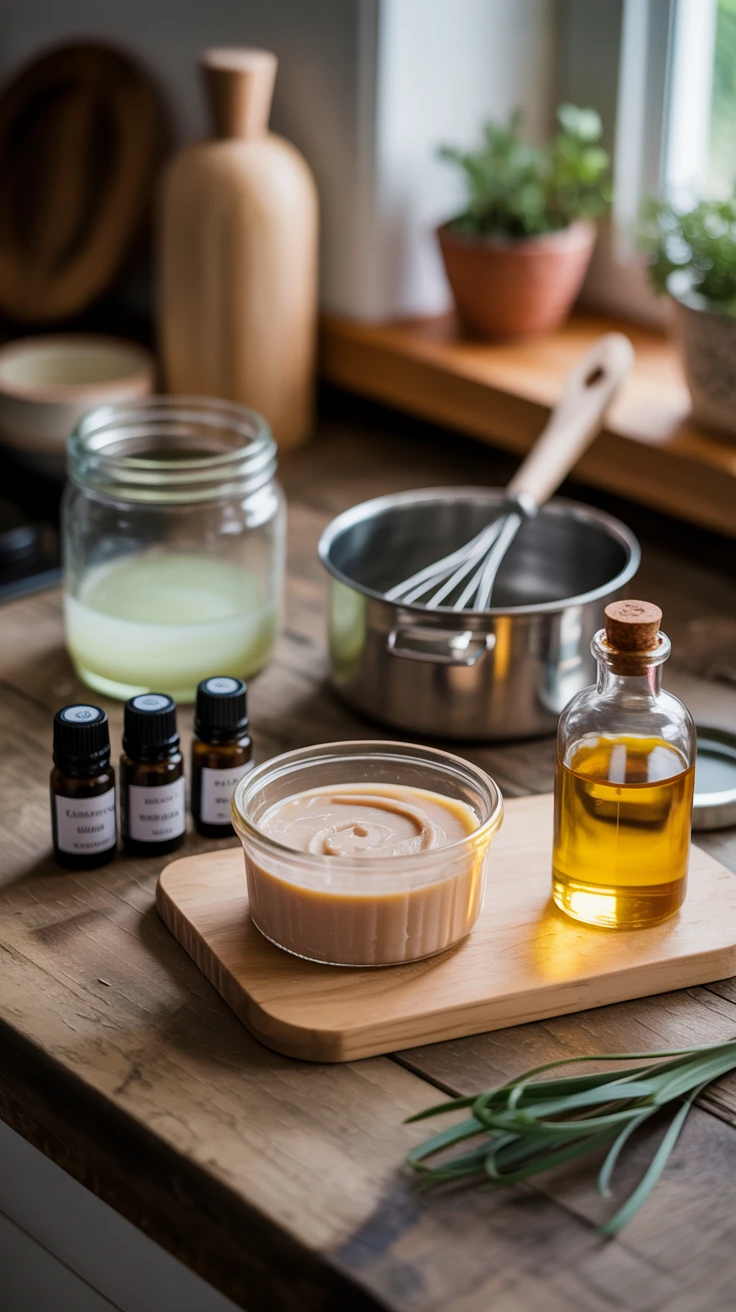
Learning how to make beef tallow face cream starts with assembling the right ingredients and tools. The beauty of this recipe is its simplicity—you only need a few high-quality components.
Basic Ingredients:
- 1 cup grass-fed beef tallow (rendered and strained)
- ¼ cup carrier oil (jojoba, sweet almond, or olive oil work beautifully)
- 10-20 drops essential oils (optional, for fragrance and additional benefits)
- 1 tsp vitamin E oil (optional, as a natural preservative)
Equipment You’ll Need:
- Double boiler (or a heat-safe bowl over a pot of simmering water)
- Whisk or hand mixer
- Glass jars for storage
- Fine mesh strainer (if rendering your own tallow)
- Digital kitchen thermometer (helpful but not essential)

View on AmazonAs an Amazon Associate, I earn from qualifying purchases.

View on AmazonAs an Amazon Associate, I earn from qualifying purchases.
I’ve found that investing in good quality glass containers with tight-fitting lids makes a huge difference in preserving your cream’s freshness. Those cute little amber jars aren’t just Instagram-worthy—they actually help protect your product from light degradation!
3. Sourcing Quality Beef Tallow
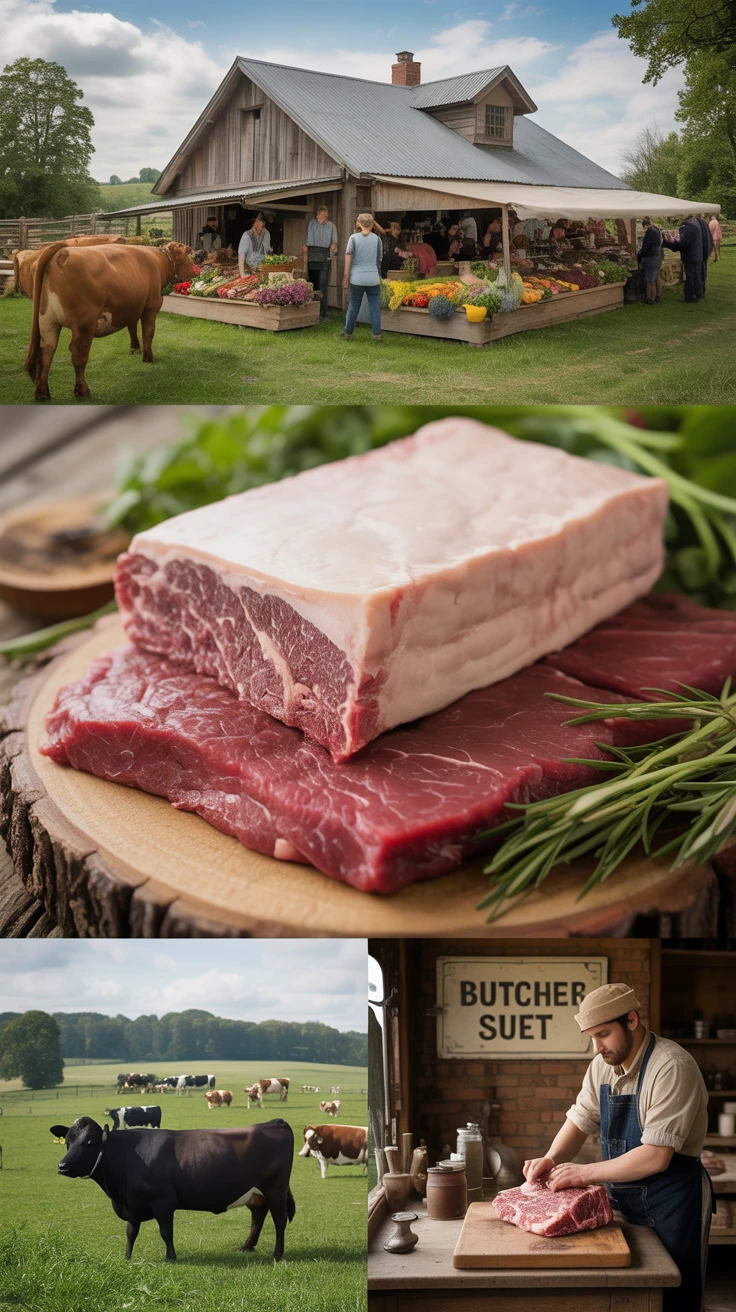
The foundation of an effective tallow face cream is high-quality tallow. You have two main options: purchase pre-rendered tallow or render it yourself from raw beef fat.
Where to Find Good Tallow:
- Local farmers who raise grass-fed cattle
- Butcher shops that process their own meat
- Farmers markets
- Online specialty shops
- Health food stores (some carry rendered tallow)
When I started making tallow skincare, I was surprised by how willing local farmers were to sell me beef suet (the raw fat) at affordable prices—sometimes they even gave it away! Many don’t realize its value and are happy to find someone who appreciates it.
Pro Tip: Always ask for “suet” or “kidney fat” specifically when sourcing raw fat for rendering. This harder fat from around the kidneys and loins produces the cleanest, least fragrant tallow—ideal for skincare applications.
4. Rendering Your Own Tallow (Optional Step)
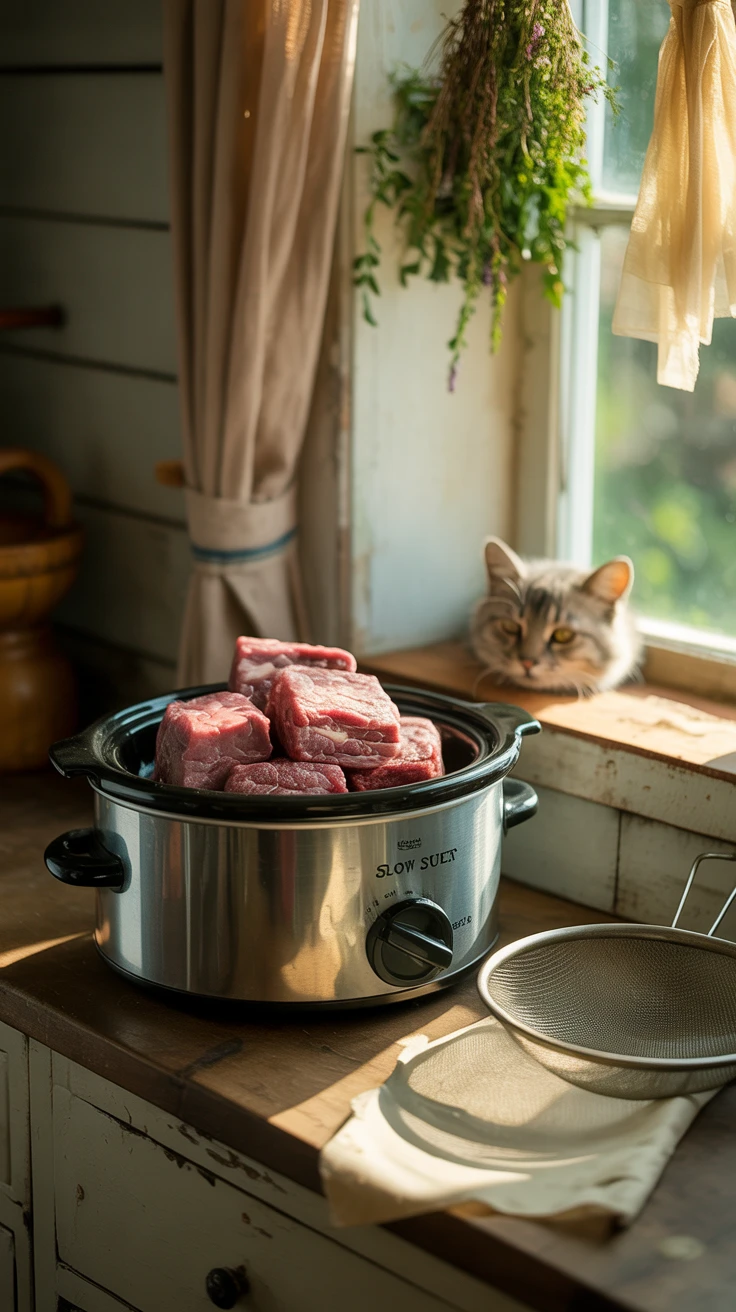
If you’re starting with raw beef suet, you’ll need to render it first. Don’t be intimidated—rendering is simply the process of melting and purifying the fat. I find there’s something deeply satisfying about transforming this raw ingredient into something precious.
Simple Rendering Method:
- Cut the suet into small chunks, removing any meat or blood spots
- Place in a slow cooker on low heat (or in a heavy pot on the stovetop over very low heat)
- Let it melt slowly for several hours, stirring occasionally
- When the fat has liquefied and the solid bits (cracklings) have sunk to the bottom, strain through a fine mesh strainer lined with cheesecloth
- Pour into clean jars and allow to cool completely (it will solidify into a creamy white substance)
The first time I rendered tallow, my kitchen did have a slight “cooked fat” aroma, but it wasn’t nearly as strong as I feared. Opening windows and simmering some cinnamon sticks in water afterward took care of any lingering scent.

View on AmazonAs an Amazon Associate, I earn from qualifying purchases.

View on AmazonAs an Amazon Associate, I earn from qualifying purchases.
Pro Tip: For an extra-pure tallow, you can “wet render” by adding about 1 cup of water to the pot while melting. The water helps separate impurities, and you can easily remove them once the tallow solidifies and the water freezes beneath it.
5. Basic Beef Tallow Face Cream Recipe
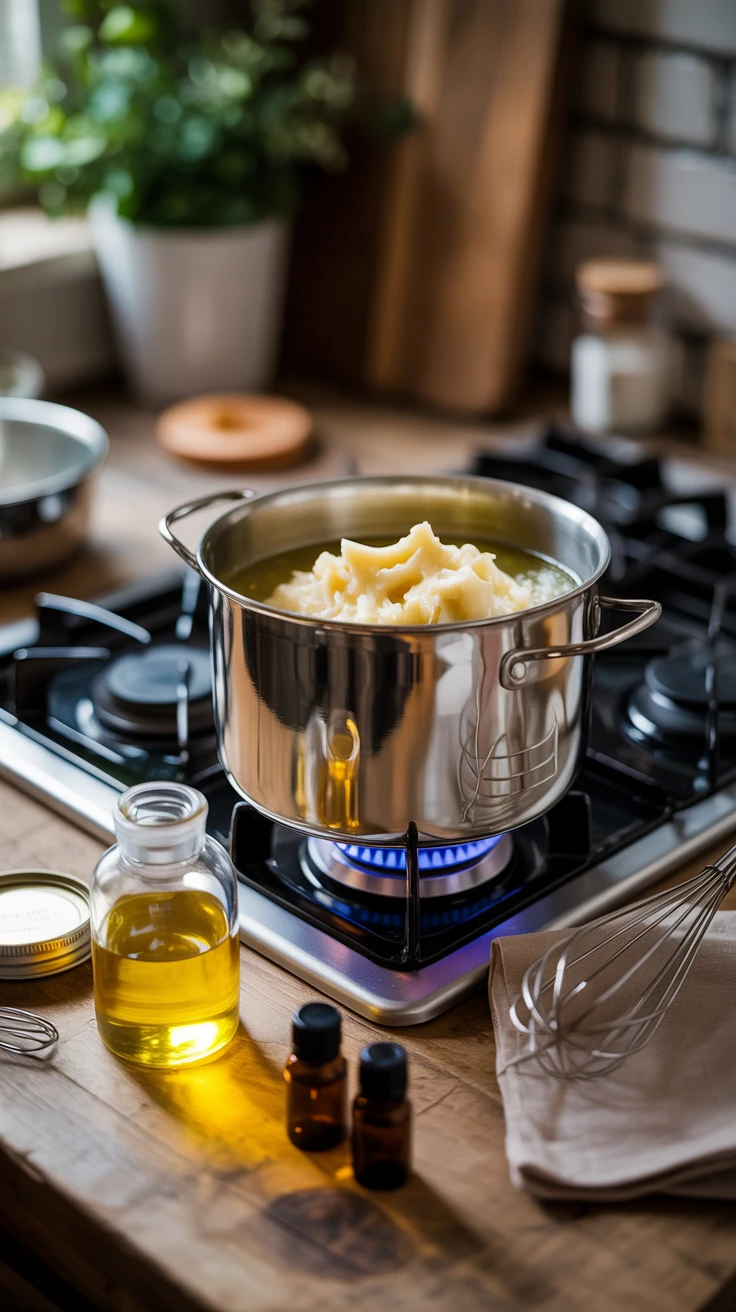
Now for the heart of how to make beef tallow face cream—the actual mixing process! This basic recipe creates a smooth, easily absorbed cream that provides deep moisture without feeling heavy.
Step-by-Step Instructions:
- Gently melt 1 cup of tallow in your double boiler until just liquefied (around 140°F—don’t overheat)
- Remove from heat and let cool slightly (to about 120°F)
- Slowly whisk in ¼ cup of your chosen carrier oil
- Add vitamin E oil if using (this extends shelf life)
- Allow the mixture to cool until it begins to turn opaque but is still soft
- Whip with a hand mixer or whisk vigorously for 2-3 minutes to incorporate air (this creates a lighter texture)
- Transfer to clean glass jars before it solidifies completely
The first batch I made was a revelation—it melted perfectly into my skin and left it feeling nourished but not greasy. I couldn’t believe something so simple could outperform my expensive commercial creams!

View on AmazonAs an Amazon Associate, I earn from qualifying purchases.
![FORGE SKIN® Wrinkle Defense Beef Tallow Balm for Men [TALLOW-BASED] Moisturizer for Face Hydration - Hydrating Anti Aging Skin Cream - Natural Facial Skincare Lotion with Essential Oils (1.7 OZ)](https://m.media-amazon.com/images/I/41pt7+p3imL._SL500_.jpg)
View on AmazonAs an Amazon Associate, I earn from qualifying purchases.
Pro Tip: The ratio of tallow to liquid oil affects the final consistency. For a firmer cream, use less oil; for a softer, more spreadable texture, add a bit more. Experiment to find your perfect balance.
6. Customizing Your Tallow Face Cream with Essential Oils
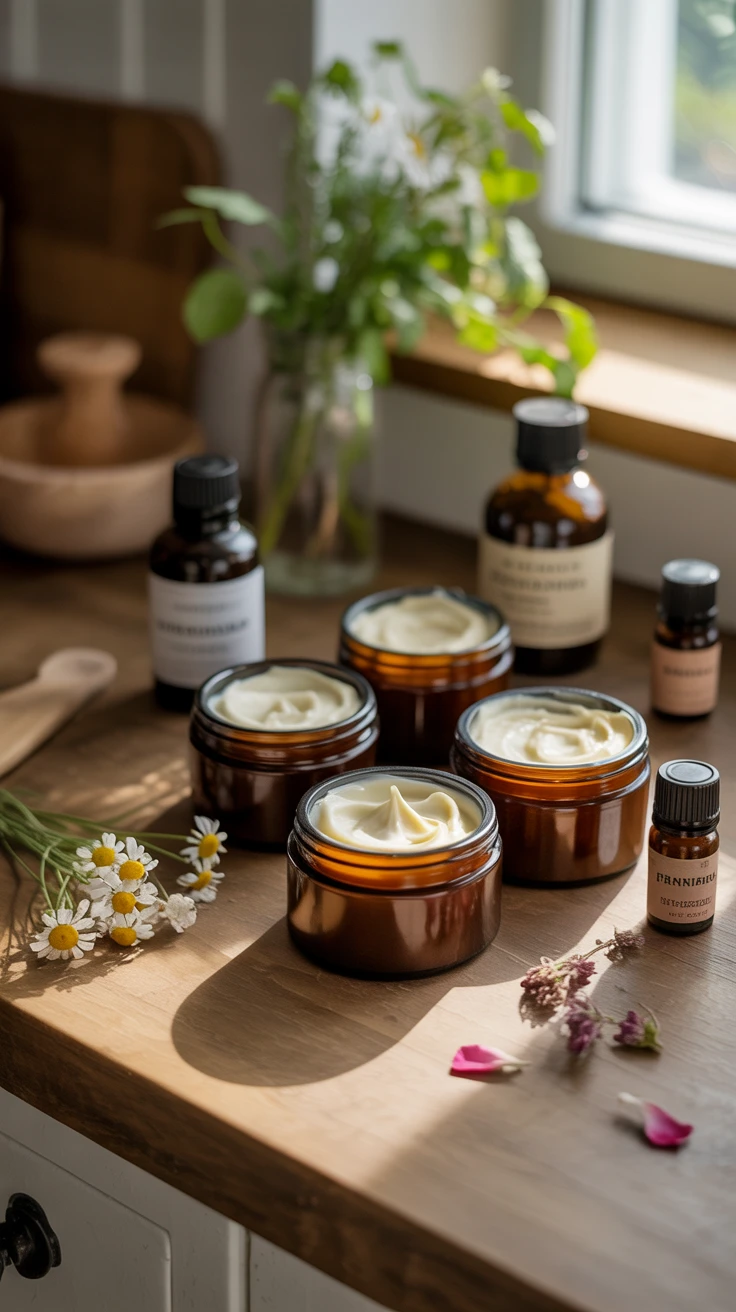
One of the joys of making your own skincare is the ability to customize it exactly to your preferences and needs. This is where essential oils come in—they not only mask the subtle tallow scent but add therapeutic benefits too.
Essential Oil Suggestions by Skin Type:
- Dry/Mature Skin: Frankincense, rose, geranium, sandalwood
- Oily/Acne-Prone: Tea tree, lavender, lemongrass, bergamot
- Sensitive Skin: Chamomile, lavender, helichrysum
- Combination Skin: Ylang-ylang, lavender, neroli
- Anti-Aging Focus: Frankincense, myrrh, rose, carrot seed
When I first started making tallow cream, I was concerned about a lingering beefy smell. I needn’t have worried! A combination of lavender and frankincense not only created a pleasant, subtle fragrance but also enhanced the cream’s skin-calming properties.
Pro Tip: Add essential oils after the mixture has cooled below 120°F to preserve their therapeutic properties. Start with fewer drops than you think you need—you can always add more, but you can’t take them out!
7. Storage and Shelf Life of Your Homemade Tallow Cream
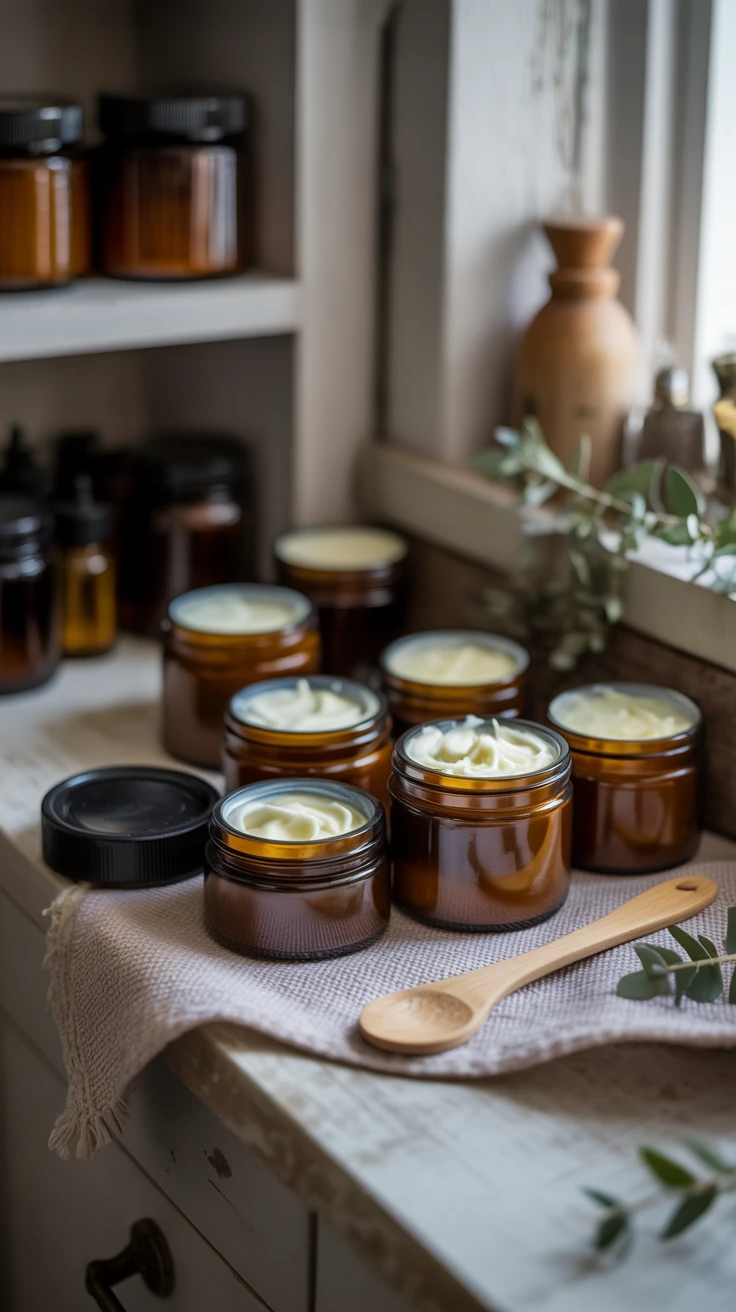
Proper storage is crucial for maintaining the quality and effectiveness of your tallow face cream. Since it doesn’t contain commercial preservatives, you’ll need to be mindful of keeping it fresh.
Storage Guidelines:
- Store in airtight glass containers (amber or cobalt blue glass offers UV protection)
- Keep in a cool, dark place—avoid bathroom shelves near showers (humidity and heat accelerate spoilage)
- Use clean, dry fingers or a small spatula to remove cream from the container
- Consider keeping small amounts in your bathroom and the rest in the refrigerator
A properly stored tallow cream typically lasts 3-6 months at room temperature. Adding vitamin E oil as a natural preservative can extend this time. If refrigerated, it can last up to a year, though the texture may become firmer (just let it warm in your hands before applying).
Pro Tip: Make smaller batches more frequently rather than one large batch. I’ve found that 4-ounce jars are perfect—enough to last a month or two without risking spoilage.
8. How to Apply Beef Tallow Face Cream for Maximum Benefits
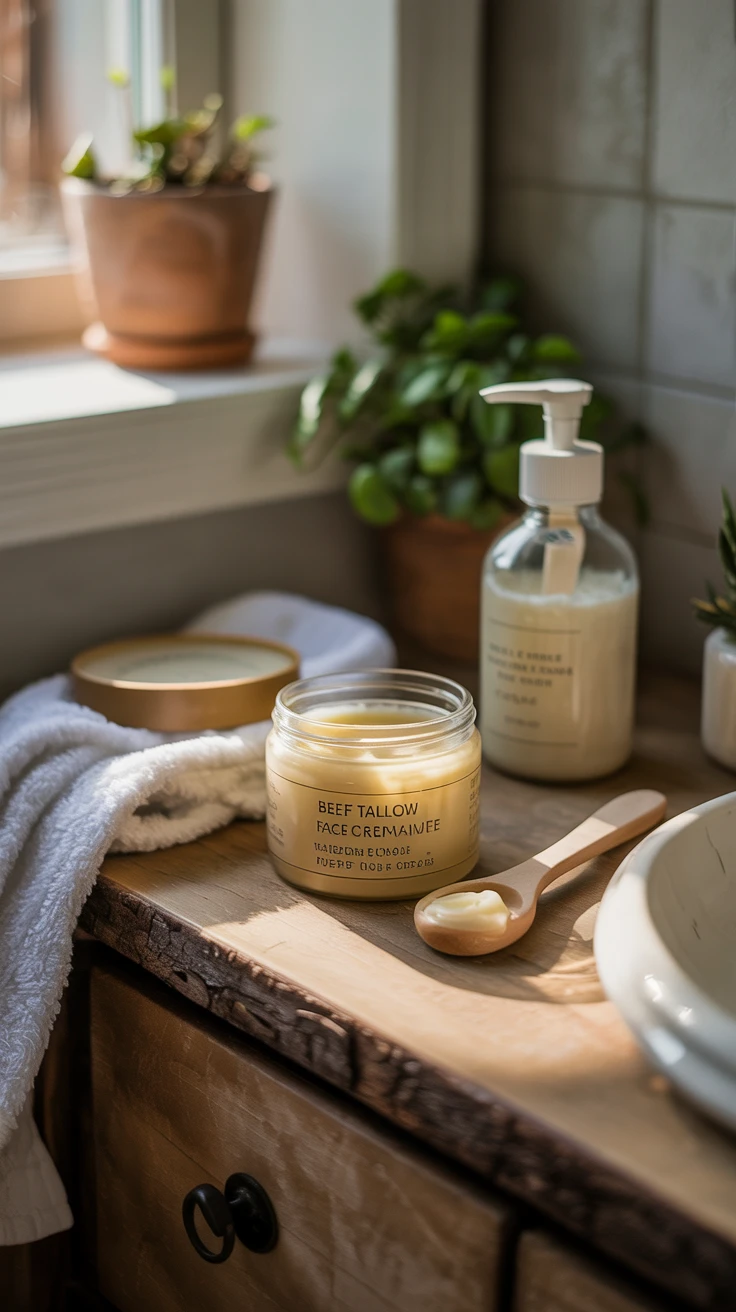
Learning how to make beef tallow face cream is just the beginning—proper application ensures you reap all its nourishing benefits. Tallow creams are more concentrated than commercial moisturizers, so a little goes a long way.
Application Method:
- Cleanse face with a gentle cleanser and pat slightly damp (not completely dry)
- Scoop a small amount (pea-sized) with clean fingers
- Warm between your fingers or palms until it softens
- Gently press and pat (don’t rub) onto your face, working from the center outward
- Pay special attention to dry areas like cheeks and around eyes
- Allow 5-10 minutes to fully absorb before applying makeup
I’ve found that applying tallow cream to slightly damp skin helps it spread more easily and locks in that extra moisture. My nighttime ritual now includes applying a slightly thicker layer as an overnight treatment—I wake up with noticeably plumper, more hydrated skin.
Pro Tip: Tallow cream makes an excellent eye cream and lip balm too! For lips, mix in a bit of beeswax for extra staying power.
9. Potential Skin Benefits of Regular Tallow Cream Use
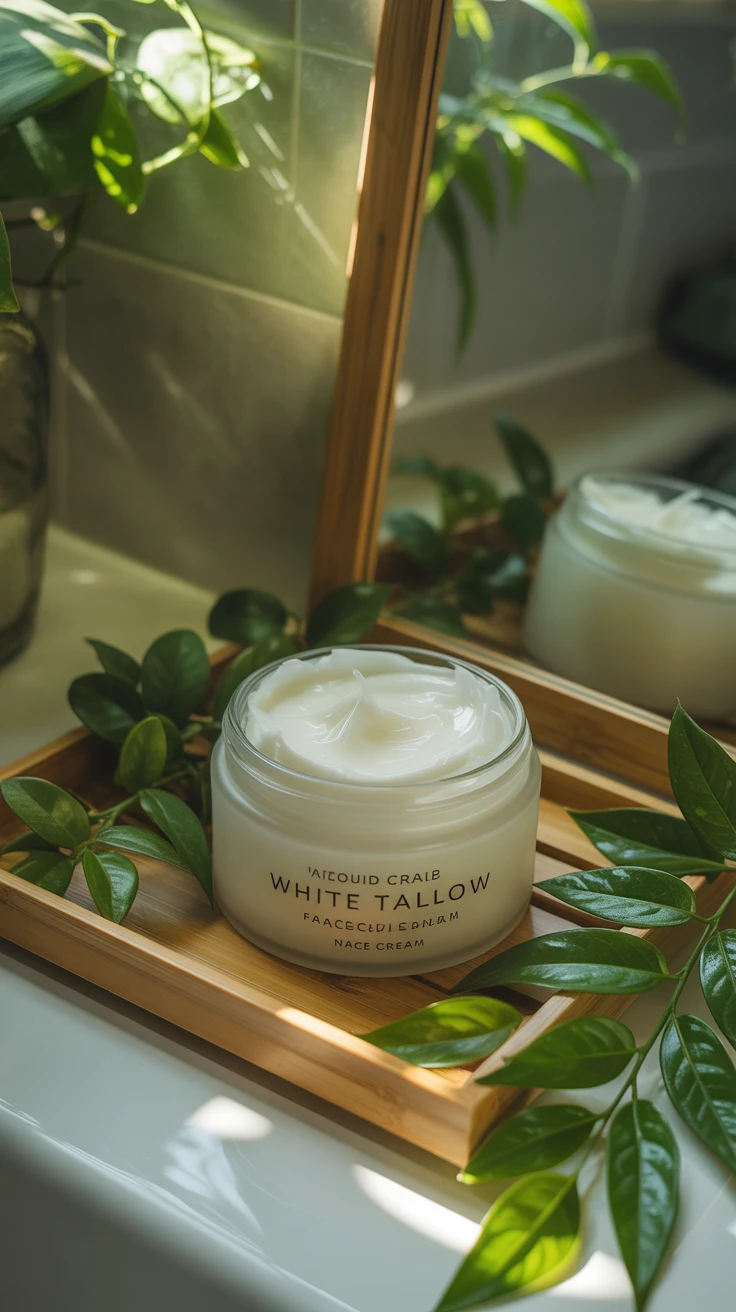
After making the switch to tallow-based skincare, many people (myself included) notice significant improvements in their skin. The compatibility between tallow’s fatty acid profile and our skin’s natural sebum is truly remarkable.
Common Benefits Reported:
- Increased moisture retention and reduced dryness
- Smoother texture and diminished fine lines
- Reduced inflammation and redness
- Faster healing of minor irritations
- More balanced oil production
- Improved resilience against environmental stressors
- A healthy, natural glow rather than artificial shine
When I first started using tallow cream, the most dramatic change was in the persistent dry patches around my nose and forehead—they simply disappeared after about two weeks of consistent use. Friends started commenting on my “glowing” complexion, asking if I’d had some fancy treatment!
Pro Tip: Give your skin at least 3-4 weeks to adjust to tallow skincare. Some people experience a brief “purging” period as skin adapts to this nutrient-dense moisturizer.
10. Troubleshooting Common Issues with Homemade Tallow Cream
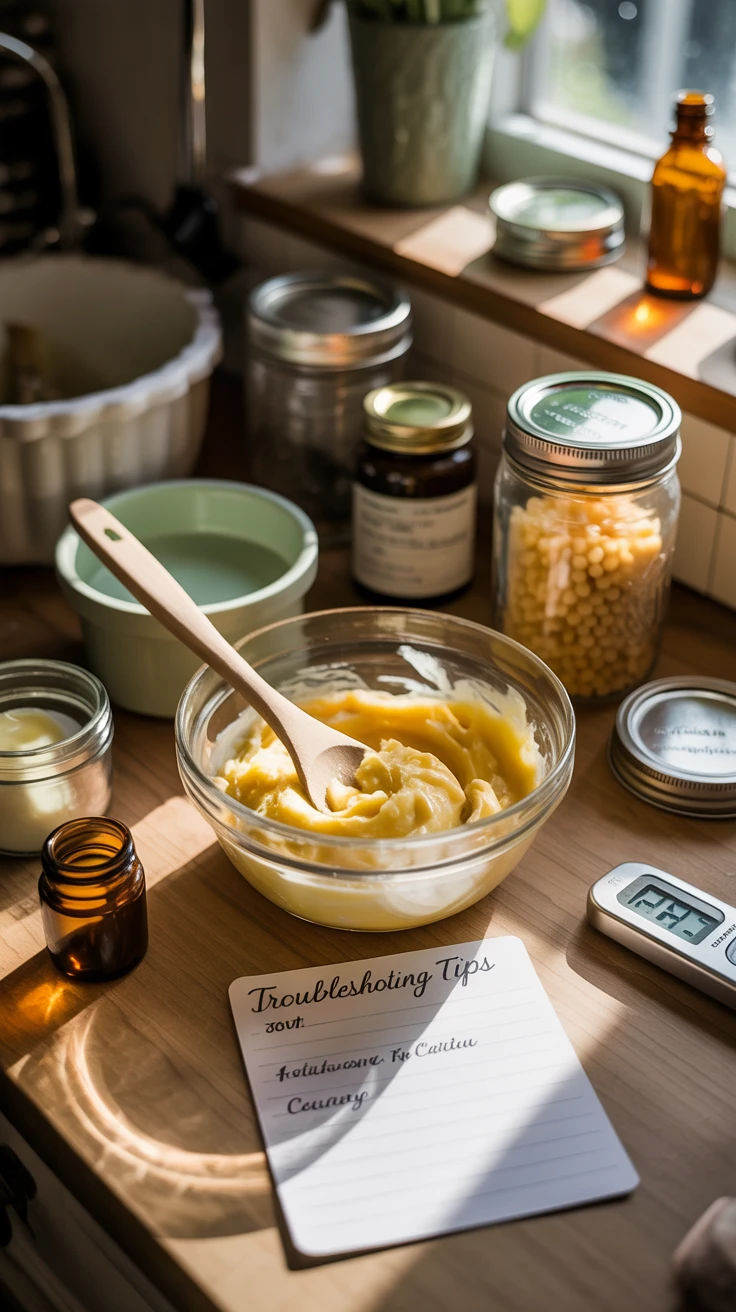
Even with a simple recipe like tallow face cream, you might encounter some challenges. Here are solutions to the most common issues:
Problem-Solving Guide:
- Cream is too hard: Increase the ratio of liquid oil or whip more air into the mixture
- Cream is too soft/oily: Add more tallow or a small amount of beeswax
- Lingering meaty smell: Ensure tallow is properly rendered; increase essential oil content or try different scent combinations
- Cream separating: Make sure ingredients are properly emulsified while still warm; try whipping longer
- Skin reaction or breakouts: Check the quality of your tallow; you might need to purify it further or switch essential oils
My first batch had a slightly granular texture because I let the tallow cool too much before whipping. I simply remelted it gently and tried again with much better results. Don’t be discouraged if your first attempt isn’t perfect—each batch gets better!
Pro Tip: Keep notes on each batch you make, recording exact measurements, temperatures, and results. This “tallow journal” becomes invaluable as you perfect your personal formula.
Key Takeaways
- Beef tallow has a molecular structure similar to human sebum, making it exceptionally compatible with our skin
- Quality matters—always seek grass-fed, properly rendered tallow for the best skincare results
- The basic recipe is simple: tallow + carrier oil + optional essential oils and vitamin E
- Customization is one of the biggest advantages of making your own face cream
- Proper storage extends shelf life—cool, dark places in airtight glass containers are ideal
Conclusion
Mastering how to make beef tallow face cream connects us to traditional wisdom while addressing modern skincare needs. There’s something profoundly satisfying about creating a product that’s not only effective but also sustainable, economical, and completely transparent in its ingredients. The journey from raw tallow to luxurious face cream might seem unusual in our world of synthetic beauty products, but the results speak for themselves.
If you’re tired of expensive creams with questionable ingredients, I encourage you to try this ancestral approach to skincare. Your skin (and probably your wallet) will thank you. Remember, the best skincare doesn’t always come in fancy packaging with a hefty price tag—sometimes it comes from your own kitchen, crafted with care and simple, natural ingredients. Happy tallow-making!
Frequently Asked Questions
Is beef tallow face cream good for sensitive skin?
Yes, many people with sensitive skin find tallow-based creams to be gentle and non-irritating. The similar fatty acid profile to our skin’s natural oils makes it less likely to cause reactions than synthetic ingredients. However, as with any skincare product, perform a patch test first and start with a simple formula without essential oils if you’re particularly sensitive.
How long does homemade tallow face cream last?
Properly stored homemade tallow face cream typically lasts 3-6 months at room temperature and up to a year if refrigerated. Adding vitamin E oil as a natural preservative can extend shelf life. Always check for any changes in smell, color, or texture before use, as these could indicate spoilage.
Can I use tallow from any part of the cow?
While you can technically use tallow rendered from any beef fat, the suet (kidney fat) produces the highest quality, least scented tallow for skincare purposes. This harder fat has a better fatty acid profile and creates a more stable final product with less noticeable scent.
Does beef tallow face cream cause breakouts?
Pure, properly rendered tallow is non-comedogenic for most people and often helps balance oil production. However, individual skin responses vary. If you’re


